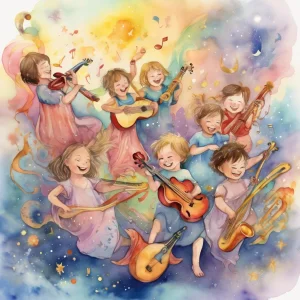Activity
Similar Activities
Enchanted Nature-Based Storytelling Adventure
Children’s Age: 0 month – 6 years
Activity Duration: 5 – 10 minutes
Let's have fun with Nature-Based Storytelling! Find a cozy outdoor spot, lay down a blanket, and bring a basket for collecting leaves and stones. Sit with your child, explore natur…
Activity Duration: 5 – 10 minutes
Sensory Ball Play: Texture Discovery for Infants
Children’s Age: 3 – 6 months
Activity Duration: 5 minutes
Explore sensory play with textured balls designed for infants aged 3 to 6 months to enhance their sensory, social-emotional, motor, and language skills. Set up a cozy space with so…
Activity Duration: 5 minutes
Enchanted Storybook Illustration Adventure
Children’s Age: 6–10 years
Activity Duration: 25 minutes
Engage children aged 6 to 10 in the "Storybook Illustration Adventure" for a creative and language-rich experience. Gather drawing materials and set up individual workspaces to ill…
Activity Duration: 25 minutes
Empathy Through Art: Digital Diversity Collage Journeys
Children’s Age: 2–2.5 years
Activity Duration: 10 minutes
The "Digital Diversity Collage" activity is designed to foster empathy, adaptive skills, and cultural awareness in children aged 24 to 30 months using art and creativity. You will …
Activity Duration: 10 minutes
Enchanted Emotions Collage Journey
Children’s Age: 2–3 years
Activity Duration: 5 minutes
The "Feelings Collage" activity is designed for children aged 24 to 36 months to explore emotions and boost empathy, cognitive abilities, and creativity. With magazines, scissors, …
Activity Duration: 5 minutes
Enchanted Musical Storytime Adventure: A Journey Through Sound
Children’s Age: 2–3 years
Activity Duration: 10 minutes
"Musical Storytime Adventure" is a delightful activity designed for children aged 24 to 36 months to enjoy a fun and educational experience. Set up by gathering picture books and c…
Activity Duration: 10 minutes
Ecosystem Adventure Board Game - Nature's Quest
Children’s Age: 7–9 years
Activity Duration: 10 – 25 minutes
An interactive board game where children explore and learn about ecosystems through challenges and tasks.
Activity Duration: 10 – 25 minutes
Musical Painting Fun: Expressive Art and Melodies
Children’s Age: 2–3 years
Activity Duration: 10 – 30 minutes
This activity involves children creating paintings while listening to music that matches the mood of sentences they choose. It helps with sensory development, and social-emotional …
Activity Duration: 10 – 30 minutes
Musical Kindness Quilt
Children’s Age: 8–10 years
Activity Duration: 10 – 20 minutes
The "Musical Kindness Quilt" activity engages 9-year-old children in learning about famous musicians while enhancing communication skills and cognitive development. Children choo…
Activity Duration: 10 – 20 minutes
Whispers of Nature Rhythms: Exploring Beats and Patterns
Children’s Age: 3–7 years
Activity Duration: 10 – 30 minutes
Let's explore "Nature Rhythms" together! We will listen to nature's beats and patterns using rocks, sticks, leaves, and pinecones. Find a safe outdoor spot, gather natural material…
Activity Duration: 10 – 30 minutes
Magical Sensory Adventures: Exploring Sensory Bins
Children’s Age: 1.5–2 years
Activity Duration: 10 minutes
Explore the "Exploring Sensory Bins" activity designed for children aged 18 to 24 months to boost play skills through tactile experiences. Gather materials like rice, toys, and sco…
Activity Duration: 10 minutes


























